Mold in your Brita filter is a disturbing sight. Since your goal is to clean your water, the last thing you want to do is contaminate it with mold spores.
Here, we’ve shared the common causes of mold in a Brita filter, and how to fix them.
📌 Key Takeaways:
- Mold in a Brita filter is caused by a lack of cleaning and failure to replace the filters on time, a humid environment, or organic materials in your water.
- Use white vinegar to clean your Brita system at least once a month to remove mold.
- You can prevent mold in your Brita pitcher by replacing the filter on time, cleaning the unit regularly, and storing the pitcher in a cool, dry location (such as your refrigerator).
Table of Contents
🔎 Why Do Brita Filters Get Mold? 3 Causes
There are several likely causes of mold in Brita filters:
A Lack Of Cleaning
The most common cause of a moldy Brita filter is a lack of cleaning.
If you don’t clean the filter and replace it as recommended, mold will begin to grow on the walls of the Brita pitcher and inside the filter cartridge.
The filter cartridge itself is especially prone to mold buildup if it’s not replaced on time, since the cartridge remains moist throughout the day – offering the ideal conditions for mold spores to grow.
Humid Environment
The location where you store your Brita pitcher could also affect the rate of mold growth in the filter.
Mold needs humidity to grow, so if your pitcher storage location is a humid room (such as a kitchen that sees a lot of steam production due to cooking), it’s more likely to be damaged by mold growth.
Organic Matter In Water
Finally, mold feeds off organic material, so if your water has a high amount of organic matter, you’re more likely to notice mold in your Brita filter.
This is most common in unpurified well water, not in treated city water.
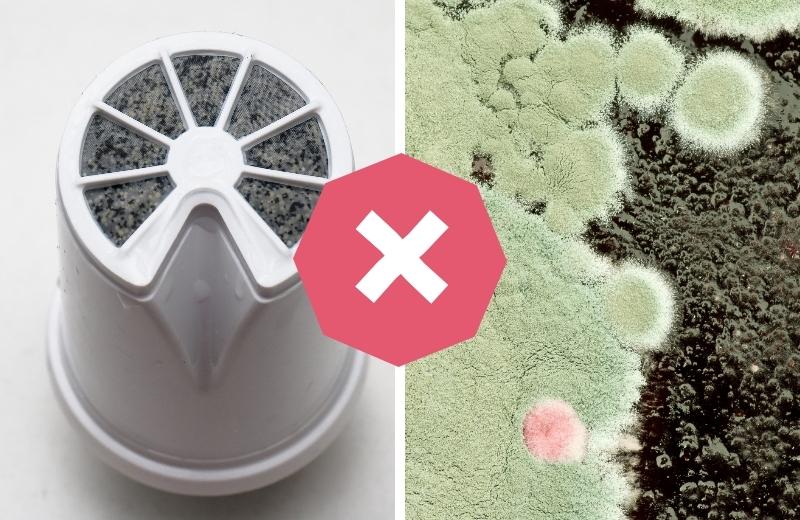
🤔 How Does Mold Grow On Brita Filters?
You might still be wondering how a Brita water filter, which is designed to remove contaminants from your water, ends up accumulating mold.
The reason is actually, in part, due to Brita’s contaminant removal. The Brita filter pitcher removes chlorine, a chemical that’s used to disinfect municipal drinking water, killing the likes of bacteria, viruses, and fungi.
👨🔧 Because this chlorine is removed, your water is more likely to be re-contaminated with these microorganisms. If you don’t clean the filter and housing as recommended, and you don’t replace the filter on time, organic matter will accumulate.
There are plenty of crevices that organic matter can get trapped in, including the area between the filter and the housing, and the pitcher’s spout.
Mold growth in the filter will be worsened if there are mold spores in the air. Many people are victims of mold exposure in their own homes, without even knowing it.
☠️ Is Mold In Brita Filters Dangerous?
Yes, mold in a Brita filter is dangerous. Mold is a type of fungus that can be toxic, and extended mold exposure has a number of concerning health effects. The types of mold that grow in damp locations (such as Brita water filters) produce mycotoxins, which could cause mold poisoning.
There are dangers of drinking tap water containing mold, just as there are dangers of breathing mold in the air. Mold allergies are most common in children, infants, the elderly, pregnant women, and folks with compromised immune systems.
Some of the symptoms you may experience from mold exposure are:
- Sneezing
- Headaches
- Coughing
- Watery eyes
- Sinus irritation
- Wheezing
People with asthma may also experience asthma attacks as a result of being exposed to mold, and those with existing health conditions may develop infections in their upper respiratory tract and lungs.
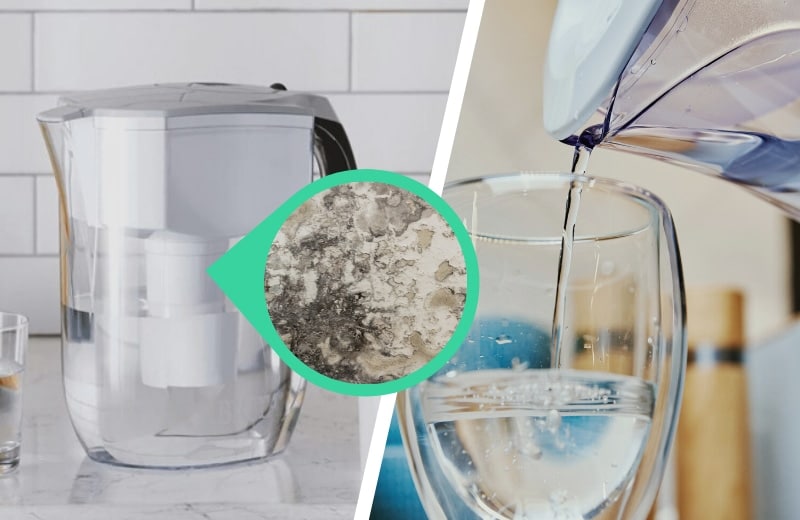
🧫 Types Of Mold In Brita Filters
There are various types of mold, which can be divided into three categories: toxigenic mold (which produces toxins), allergenic mold (which causes allergies and asthma flare-ups), and pathogenic mold (which makes you sick).
We’re most familiar with black mold, and this is the mold that you’re most likely to see in a Brita filter. However, there are other colored molds that may grow on the filter, too, including pink mold, green mold, and gray/white mold.
Check out the common types of molds in the table below.
| Mold | Type | Classification | How it looks | Where it grows | Harmful effects |
|---|---|---|---|---|---|
| Alternaria | Green | Allergenic | Velvet texture | Tubs, sinks, and shower | Sneezing, itchy eyes, wheezing |
| Aspergillus | Green | Allergenic | Light-green/yellow, forms circular patches | Anywhere in the house | Asthma attacks, lung infections |
| Cladosporium | Green | Allergenic | Olive green, suede-like texture | Cupboards, fabrics, upholstery | Allergic fungal sinusitis, asthma attacks |
| Penicillin | Green | Allergenic | Blue-green | Carpets/wallpapers | Allergic reactions or infections |
| Aureobasidium | Black | Allergenic | Dark brown/ black-colored patches | Wooden surfaces | Asthma, hay fever, hypersensitivity pneumonitis |
| Chaetomium | Black | Allergenic | Black, cotton candy-like texture | Damaged pipes and structures | Nail and skin fungal infections |
| Stachybotrys | Black | Allergenic + toxigenic | Black, slimy texture | Damp wood or cardboard | Body ache, burning eyes |
| Ulocladium | Black | Allergenic | Egg-shaped, black strips | Water damaged wood | Skin infections, hay fever |
| Serratia marcescens (bacteria) | Pink | Allergenic + pathogenic | Pinking-orange film | Sink, toilet, bathtubs | Respiratory infections, pneumonia, bloodstream infections |
🆚 Mold Vs Mildew Vs Algae
Mold isn’t the only thing that could grow in a Brita pitcher. Algae and mildew are two other impurities that thrive in the damp, humid environment of a water filter.
What’s the difference between these three contaminants?
- Mold is usually black or green, and may have a slimy or fuzzy texture. It thrives in dark, damp environments and produces circular markings on the filter’s surface.
- Mildew is a powdery, light fungus that’s usually found in shades of gray, yellow, and white. You’re more likely to find powdery mildew on your plastic filter housing and pouring spout.
- Algae is a green or turquoise bacteria with a slimy texture. Light and moisture are the two factors needed for algae growth. Algae is most likely to grow on a Brita water pitcher that sits in direct sunlight (through a window, for instance).
🧼 How To Clean A Moldy Brita Filter
We recommend throwing out your Brita water filter if you discover mold on the filter cartridge itself. If it’s time for a new filter, then there’s nothing better than buying a replacement.
The filtration system should, however, be cleaned periodically to remove mold. Clean the unit once a month or when you replace the filter.
No matter where you spot the mold, it’s important to clean it off as soon as you notice it. When left to accumulate, mold becomes more difficult to remove and more dangerous to your health.
Below, we’ve shared how to remove mold from various types of Brita products.
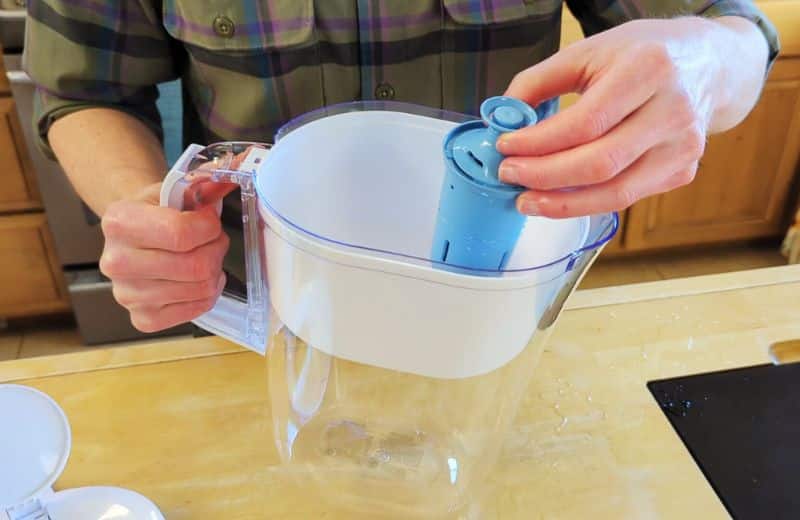
How to Remove Mold From a Brita Pitcher
These instructions apply to both the Brita Standard filter and the Brita Elite filter (both of which are found in Brita pitcher models).
- Make safety preparations. Put on a pair of cleaning gloves and a mask to minimize your exposure to the mold spores.
- Remove the filter. Take the filter housing out of the Brita pitcher and remove the filter.
- Wash everything. Fill a bowl with hot water with dish soap and wash the lid, pitcher, and filter housing. Use a sponge or old toothbrush to scrub the mold off the parts. Make sure to focus on the corners and crevices.
- (Optional): Upgrade to white vinegar. You can treat difficult-to-remove mold stains with a solution of equal parts water and white vinegar.
- Rinse and dry. Rinse the parts and wait for them to air dry.
- Replace the filter (if necessary). Flush the new filter under running water then put it in the housing, screwing it in place.
- Filter a batch of water. Add water to the Brita pitcher, then wait for it to filter and discard the batch of water.
Related: Is Brita dishwasher safe?
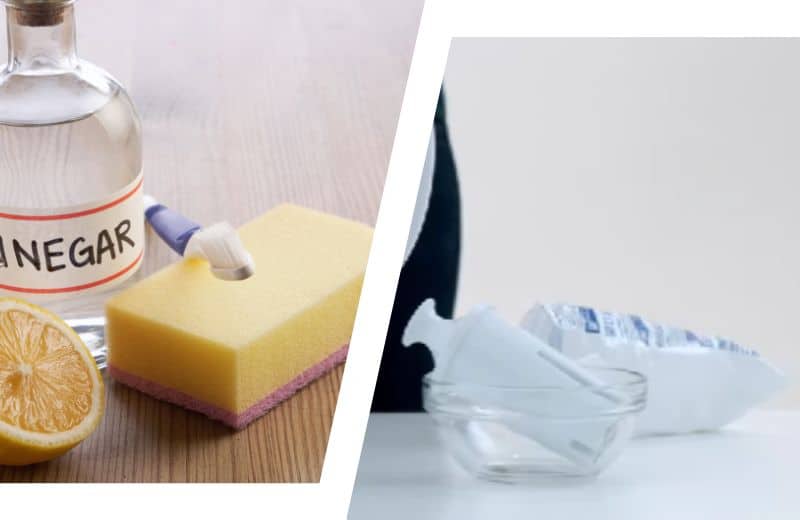
How to Remove Mold From a Brita Faucet Filter
- Make safety preparations. Put on a mask and a pair of cleaning gloves.
- Remove the old filter. Take the filter out of the faucet filter housing.
- Wipe down the filter unit. Soak a cloth in a 50/50 white vinegar and water solution, then use it to clean the filter unit.
- Clean the filter housing. Use the same solution to scrub the filter housing, using an old toothbrush to get into the crevices.
- Rinse and wipe clean. Rinse the filter and use a clean cloth or dish towel to wipe away the residue.
- Attach and flush the filter (if necessary). Put the new filter in the housing and flush it with tap water according to the manufacturer’s instructions.
📌 Note: We recommend using vinegar because it’s effective and non-toxic, but you can use a diluted bleach solution if vinegar doesn’t suffice.
How to Remove Mold From a Brita Water Bottle Filter
- Make safety preparations. Put on a mask and a pair of cleaning gloves.
- Disassemble the bottle. Unscrew the lid from the bottle and remove the filter.
- Clean the bottle. Fill a bowl with warm water and dish soap, then soak the bottle and use a sponge or toothbrush to clean the mold. Focus on the lid, the straw, and the filter housing.
- Rinse and dry. Rinse the bottle under running warm water and leave it to air-dry.
- Attach the replacement filter (if needed). Click the new filter into the end of the straw and put the lid back on the bottle.
🚫 How To Prevent Mold In Brita Filter
Below, we’ve shared a few tips for preventing mold growth in a Brita product.
Check Air Vents
It’s common for mold to grow in heating and cooling systems in your home. This increases the likelihood of mold spores in the air contaminating your water filter. Check and clean your air vents regularly.
Replace the Filter On Time
Make sure to buy a replacement filter for your Brita system as recommended. This is the best way to avoid drinking moldy water.
Here are the lifespans for various Brita filters:
| Filter Type | Lifespan |
|---|---|
| Brita Standard (in Brita pitchers) | 2 months |
| Brita Elite (in Brita pitchers) | 6 months |
| Brita faucet filter | 4 months |
| Brita water bottle filter | 2 months |
Some Brita filters have filter change indicators, so you know at a glance when a replacement filter is needed.
Store The Pitcher In A Mold-Free Location
If you have a Brita pitcher, store the pitcher in an area that isn’t affected by mold and mildew. Refrigerators are often the safest bet. Never store the pitcher in direct sunlight or in a humid kitchen.
Clean The Unit
Regardless of the Brita product you own, clean it at least once a month. This will prevent mold from growing in the filter and the other parts of the system. It’ll also prevent harmful bacteria from growing.
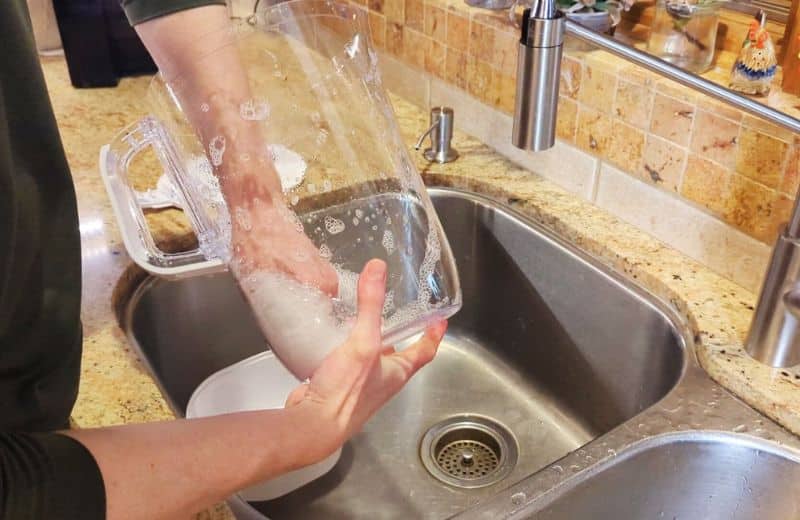
Avoid Contaminating The Filter
There are a few ways that you might contaminate the filter yourself, including touching the filter spout or cartridge without washing your hands, and drinking directly out of the pitcher.
To prevent this contamination, wash your hands before you handle the filter, and pour water from the pitcher into a separate glass.
Consider Professional Mold Removal
You won’t be able to easily prevent mold growth in your Brita system if your home itself is contaminated. Consider hiring a professional to treat the cause of the mold in your property.
❔ Brita Filter Mold: FAQ
Can a Brita filter get moldy?
Yes, a Brita filter can get moldy. Filters in Brita’s pitcher models are the most prone to mold growth because of the filter’s constantly damp environment. If your water contains a lot of organic matter, you’re even more likely to have mold growing on your Brita filter, since mold feeds off organic material.
Related: Do Brita water filters expire?
Is the Brita Elite filter more likely to have mold growth?
Yes, the Brita Elite (formerly LongLast) filter is more likely than the Brita Standard filter to have mold growth. Why? Because the filter has a 6-month lifespan. While this is good for maintenance – it means you don’t have to change the filters constantly – it also means that the ideal mold growth conditions are sustained for a longer period of time. However, regular cleaning should reduce, if not eliminate, mold growth even in a Brita Elite filter.
Why is black stuff coming out of my Brita filter?
If you have a new filter, the black stuff coming out is likely harmless carbon dust. This should clear after you’ve filtered a couple of initial batches of water. An old filter cartridge might be moldy, and that’s the source of the black stuff. If you’re concerned, replace the filter.
What are the white dots in my Brita filter?
The white spots on the bottom of your Brita filter are usually the ion exchange resin granules. Before you replace the filter, cut it open. This will show you what the resin granules look like. If the white spots on the bottom of the filter are large or textured, they could instead be mold.
Can moldy Brita make you sick?
Yes, a moldy Brita water filter could make you sick. Drinking moldy water has several potential health effects, depending on the type of mold in the filter. Some mold types produce allergy-like symptoms, while others are pathogenic and make you sick. You can avoid getting sick by cleaning the filter and buying a replacement filter when needed.
Can I use bleach to clean mold off a Brita filter?
Yes, you can use a diluted bleach solution (4-5 tablespoons of bleach per gallon of fresh water) to clean mold off a Brita tap water filter. However, we recommend using white vinegar first since this is non-toxic and safer to handle.

